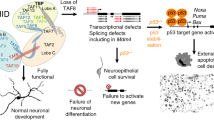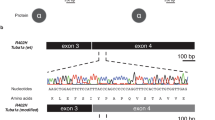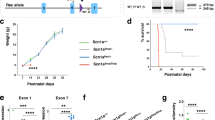Abstract
Neural tube defects (NTDs), such as spina bifida (SB) or exencephaly, are common congenital malformations leading to infant mortality or severe disability. The etiology of NTDs is multifactorial with a strong genetic component. More than 70 NTD mouse models have been reported, suggesting the involvement of distinct pathogenetic mechanisms, including faulty cell death regulation. In this review, we focus on the contribution of functional genomics in elucidating the role of apoptosis and autophagy genes in neurodevelopment. On the basis of compared phenotypical analysis, here we discuss the relative importance of a tuned control of both apoptosome-mediated cell death and basal autophagy for regulating the correct morphogenesis and cell number in developing central nervous system (CNS). The pharmacological modulation of genes involved in these processes may thus represent a novel strategy for interfering with the occurrence of NTDs
Similar content being viewed by others
Log in or create a free account to read this content
Gain free access to this article, as well as selected content from this journal and more on nature.com
or
Abbreviations
- Ambra1:
-
activating molecule in Beclin 1-regulated autophagy
- ATG:
-
autophagy-related gene
- CNS:
-
central nervous system
- E:
-
embryonic day
- IP3:
-
myo-inositol-1,4,5-triphosphate
- Lamp:
-
lysosome-associated membrane protein
- NPC:
-
neuronal precursor cell
- NTDs:
-
neural tube defects
- PI3K:
-
phosphatidyl Inositol 3-kinase
- SB:
-
spina bifida
- TUNEL:
-
terminal uridine deoxynucleotidyl transferase dUTP nick end labeling
References
Eskes TK . From birth to conception. Open or closed. Eur J Obstet Gynecol Reprod Biol 1998; 78: 169–177.
Gibson KM, Bottiglieri T . Genetic predisposition to neural tube defects? Pediatr Res 2000; 48: 135.
Colas JF, Schoenwolf GC . Towards a cellular and molecular understanding of neurulation. Dev Dyn 2001; 221: 117–145.
Rogner UC, Spyropoulos DD, Le Novere N, Changeux JP, Avner P . Control of neurulation by the nucleosome assembly protein-1-like 2. Nat Genet 2000; 25: 431–435.
Smith JL, Schoenwolf GC . Neurulation: coming to closure. Trends Neurosci 1997; 20: 510–517.
Tanabe Y, Jessell TM . Diversity and pattern in the developing spinal cord. Science 1996; 274: 1115–1123.
Copp AJ, Brook FA, Estibeiro JP, Shum AS, Cockroft DL . The embryonic development of mammalian neural tube defects. Prog Neurobiol 1990; 35: 363–403.
Corcoran J . What are the molecular mechanisms of neural tube defects? Bioessays 1998; 20: 6–8.
Fleming A, Copp AJ . Embryonic folate metabolism and mouse neural tube defects. Science 1998; 280: 2107–2109.
Juriloff DM, Gunn TM, Harris MJ, Mah DG, Wu MK, Dewell SL . Multifactorial genetics of exencephaly in SELH/Bc mice. Teratology 2001; 64: 189–200.
Juriloff DM, Harris MJ . Mouse models for neural tube closure defects. Hum Mol Genet 2000; 9: 993–1000.
Murdoch JN, Rachel RA, Shah S, Beermann F, Stanier P, Mason CA et al. Circletail, a new mouse mutant with severe neural tube defects: chromosomal localization and interaction with the loop-tail mutation. Genomics 2001; 78: 55–63.
van Straaten HW, Copp AJ . Curly tail: a 50-year history of the mouse spina bifida model. Anat Embryol (Berl) 2001; 203: 225–237.
Harris MJ, Juriloff DM . Genetic landmarks for defects in mouse neural tube closure. Teratology 1997; 56: 177–187.
Stegmann K, Boecker J, Richter B, Capra V, Finnell RH, Ngo ET et al. A screen for mutations in human homologues of mice exencephaly genes Tfap2alpha and Msx2 in patients with neural tube defects. Teratology 2001; 63: 167–175.
Harris MJ, Juriloff DM . Mini-review: toward understanding mechanisms of genetic neural tube defects in mice. Teratology 1999; 60: 292–305.
Herrera E, Samper E, Blasco MA . Telomere shortening in mTR−/− embryos is associated with failure to close the neural tube. EMBO J 1999; 18: 1172–1181.
De Zio D, Giunta L, Corvaro M, Ferraro E, Cecconi F . Expanding roles of programmed cell death in mammalian neurodevelopment. Semin Cell Dev Biol 2005; 16: 281–294.
Hidalgo A, ffrench-Constant C . The control of cell number during central nervous system development in flies and mice. Mech Dev 2003; 120: 1311–1325.
Kuan CY, Roth KA, Flavell RA, Rakic P . Mechanisms of programmed cell death in the developing brain. Trends Neurosci 2000; 23: 291–297.
Nicotera P . Development and death of neurons: sealed by a common fate? Cell Death Differ 2002; 9: 1277–1278.
Deckwerth TL, Elliott JL, Knudson CM, Johnson Jr EM, Snider WD, Korsmeyer SJ . BAX is required for neuronal death after trophic factor deprivation and during development. Neuron 1996; 17: 401–411.
White FA, Keller-Peck CR, Knudson CM, Korsmeyer SJ, Snider WD . Widespread elimination of naturally occurring neuronal death in Bax-deficient mice. J Neurosci 1998; 18: 1428–1439.
Shindler KS, Latham CB, Roth KA . Bax deficiency prevents the increased cell death of immature neurons in bcl-x-deficient mice. J Neurosci 1997; 17: 3112–3119.
Lindsten T, Golden JA, Zong WX, Minarcik J, Harris MH, Thompson CB . The proapoptotic activities of Bax and Bak limit the size of the neural stem cell pool. J Neurosci 2003; 23: 11112–11119.
Haydar TF, Kuan CY, Flavell RA, Rakic P . The role of cell death in regulating the size and shape of the mammalian forebrain. Cereb Cortex 1999; 9: 621–626.
Kuida K, Haydar TF, Kuan CY, Gu Y, Taya C, Karasuyama H et al. Reduced apoptosis and cytochrome c-mediated caspase activation in mice lacking caspase 9. Cell 1998; 94: 325–337.
Kuida K, Zheng TS, Na S, Kuan C, Yang D, Karasuyama H et al. Decreased apoptosis in the brain and premature lethality in CPP32-deficient mice. Nature 1996; 384: 368–372.
Hakem R, Hakem A, Duncan GS, Henderson JT, Woo M, Soengas MS et al. Differential requirement for caspase 9 in apoptotic pathways in vivo. Cell 1998; 94: 339–352.
Roth KA, Kuan C, Haydar TF, D’Sa-Eipper C, Shindler KS, Zheng TS et al. Epistatic and independent functions of caspase-3 and Bcl-X(L) in developmental programmed cell death. Proc Natl Acad Sci USA 2000; 97: 466–471.
Zaidi AU, McDonough JS, Klocke BJ, Latham CB, Korsmeyer SJ, Flavell RA et al. Chloroquine-induced neuronal cell death is p53 and Bcl-2 family-dependent but caspase-independent. J Neuropathol Exp Neurol 2001; 60: 937–945.
Cecconi F, Alvarez-Bolado G, Meyer BI, Roth KA, Gruss P . Apaf1 (CED-4 homolog) regulates programmed cell death in mammalian development. Cell 1998; 94: 727–737.
Yoshida H, Kong YY, Yoshida R, Elia AJ, Hakem A, Hakem R et al. Apaf1 is required for mitochondrial pathways of apoptosis and brain development. Cell 1998; 94: 739–750.
Yoshida H, Okada Y, Kinoshita N, Hara H, Sasaki M, Sawa H et al. Differential requirement for Apaf1 and Bcl-X(L) in the regulation of programmed cell death during development. Cell Death Differ 2002; 9: 1273–1276.
Hara T, Nakamura K, Matsui M, Yamamoto A, Nakahara Y, Suzuki-Migishima R et al. Suppression of basal autophagy in neural cells causes neurodegenerative disease in mice. Nature 2006; 441: 885–889.
Yue Z, Jin S, Yang C, Levine AJ, Heintz N . Beclin 1, an autophagy gene essential for early embryonic development, is a haploinsufficient tumor suppressor. Proc Natl Acad Sci USA 2003; 100: 15077–15082.
Qu X, Zou Z, Sun Q, Luby-Phelps K, Cheng P, Hogan RN et al. Autophagy gene-dependent clearance of apoptotic cells during embryonic development. Cell 2007; 128: 931–946.
Fimia GM, Stoykova A, Romagnoli A, Giunta L, Di Bartolomeo S, Nardacci R et al. Ambra1 regulates autophagy and development of the nervous system. Nature 2007; 447: 1121–1125.
Eskelinen EL, Schmidt CK, Neu S, Willenborg M, Fuertes G, Salvador N et al. Disturbed cholesterol traffic but normal proteolytic function in LAMP-1/LAMP-2 double-deficient fibroblasts. Mol Biol Cell 2004; 15: 3132–3145.
Zeng M, Zhou JN . Roles of autophagy and mTOR signaling in neuronal differentiation of mouse neuroblastoma cells. Cell Signal 2008; 20: 659–665.
Suzuki K, Ohsumi Y . Molecular machinery of autophagosome formation in yeast, Saccharomyces cerevisiae. FEBS Lett 2007; 581: 2156–2161.
Tomoda T, Bhatt RS, Kuroyanagi H, Shirasawa T, Hatten ME . A mouse serine/threonine kinase homologous to C. elegans UNC51 functions in parallel fiber formation of cerebellar granule neurons. Neuron 1999; 24: 833–846.
Clarke PG . Developmental cell death: morphological diversity and multiple mechanisms. Anat Embryol (Berl) 1990; 181: 195–213.
Kegel KB, Kim M, Sapp E, McIntyre C, Castano JG, Aronin N et al. Huntingtin expression stimulates endosomal-lysosomal activity, endosome tubulation, and autophagy. J Neurosci 2000; 20: 7268–7278.
Nixon RA, Wegiel J, Kumar A, Yu WH, Peterhoff C, Cataldo A et al. Extensive involvement of autophagy in Alzheimer disease: an immuno-electron microscopy study. J Neuropathol Exp Neurol 2005; 64: 113–122.
Levine B, Yuan J . Autophagy in cell death: an innocent convict? J Clin Invest 2005; 115: 2679–2688.
Cecconi F, Di Bartolomeo S, Nardacci R, Fuoco C, Corazzari M, Giunta L et al. A novel role for autophagy in neurodevelopment. Autophagy 2007; 3: 506–508.
Ferraro E, Cecconi F . Autophagic and apoptotic response to stress signals in mammalian cells. Arch Biochem Biophys 2007; 462: 210–219.
Maiuri MC, Zalckvar E, Kimchi A, Kroemer G . Self-eating and self-killing: crosstalk between autophagy and apoptosis. Nat Rev Mol Cell Biol 2007; 8: 741–752.
Botto LD, Moore CA, Khoury MJ, Erickson JD . Neural-tube defects. N Engl J Med 1999; 341: 1509–1519.
Simeone A, Puelles E, Acampora D . The Otx family. Curr Opin Genet Dev 2002; 12: 409–415.
Stanford WL, Cohn JB, Cordes SP . Gene-trap mutagenesis: past, present and beyond. Nat Rev Genet 2001; 2: 756–768.
Nijhawan D, Honarpour N, Wang X . Apoptosis in neural development and disease. Annu Rev Neurosci 2000; 23: 73–87.
Riedl SJ, Salvesen GS . The apoptosome: signalling platform of cell death. Nat Rev Mol Cell Biol 2007; 8: 405–413.
Lakhani SA, Masud A, Kuida K, Porter Jr GA, Booth CJ, Mehal WZ et al. Caspases 3 and 7: key mediators of mitochondrial events of apoptosis. Science 2006; 311: 847–851.
Zheng TS, Hunot S, Kuida K, Momoi T, Srinivasan A, Nicholson DW et al. Deficiency in caspase-9 or caspase-3 induces compensatory caspase activation. Nat Med 2000; 6: 1241–1247.
Colell A, Ricci JE, Tait S, Milasta S, Maurer U, Bouchier-Hayes L et al. GAPDH and autophagy preserve survival after apoptotic cytochrome c release in the absence of caspase activation. Cell 2007; 129: 983–997.
Mizushima N . Autophagy: process and function. Genes Dev 2007; 21: 2861–2873.
Xie Z, Klionsky DJ . Autophagosome formation: core machinery and adaptations. Nat Cell Biol 2007; 9: 1102–1109.
Kirkegaard K, Taylor MP, Jackson WT . Cellular autophagy: surrender, avoidance and subversion by microorganisms. Nat Rev Microbiol 2004; 2: 301–314.
Liang XH, Jackson S, Seaman M, Brown K, Kempkes B, Hibshoosh H et al. Induction of autophagy and inhibition of tumorigenesis by beclin 1. Nature 1999; 402: 672–676.
Liang C, Feng P, Ku B, Dotan I, Canaani D, Oh BH et al. Autophagic and tumour suppressor activity of a novel Beclin1-binding protein UVRAG. Nat Cell Biol 2006; 8: 688–699.
Pattingre S, Tassa A, Qu X, Garuti R, Liang XH, Mizushima N et al. Bcl-2 antiapoptotic proteins inhibit Beclin 1-dependent autophagy. Cell 2005; 122: 927–939.
Takahashi Y, Coppola D, Matsushita N, Cualing HD, Sun M, Sato Y et al. Bif-1 interacts with Beclin 1 through UVRAG and regulates autophagy and tumorigenesis. Nat Cell Biol 2007; 9: 1142–1151.
Jin S, White E . Role of autophagy in cancer: management of metabolic stress. Autophagy 2007; 3: 28–31.
Lum JJ, DeBerardinis RJ, Thompson CB . Autophagy in metazoans: cell survival in the land of plenty. Nat Rev Mol Cell Biol 2005; 6: 439–448.
Rubinsztein DC, Gestwicki JE, Murphy LO, Klionsky DJ . Potential therapeutic applications of autophagy. Nat Rev Drug Discov 2007; 6: 304–312.
Ohsumi Y . Molecular dissection of autophagy: two ubiquitin-like systems. Nat Rev Mol Cell Biol 2001; 2: 211–216.
Eskelinen EL, Tanaka Y, Saftig P . At the acidic edge: emerging functions for lysosomal membrane proteins. Trends Cell Biol 2003; 13: 137–145.
Levine B, Kroemer G . Autophagy in the pathogenesis of disease. Cell 2008; 132: 27–42.
Yuan J, Lipinski M, Degterev A . Diversity in the mechanisms of neuronal cell death. Neuron 2003; 40: 401–413.
Rubinsztein DC . The roles of intracellular protein-degradation pathways in neurodegeneration. Nature 2006; 443: 780–786.
Qu X, Yu J, Bhagat G, Furuya N, Hibshoosh H, Troxel A et al. Promotion of tumorigenesis by heterozygous disruption of the beclin 1 autophagy gene. J Clin Invest 2003; 112: 1809–1820.
Acknowledgements
This work was partially supported by grants from Fondazione Telethon, Compagnia di San Paolo, AIRC, The EU 7th Framework Programme, the Italian Ministry of University and Research (MUR) and the Italian Ministry of Health; FC is an Associate Telethon Scientist. We thank Martin W Bennet for the valuable editorial work and Marcello Giorgi for the drawings in Figure 1.
Author information
Authors and Affiliations
Corresponding author
Additional information
Edited by G Melino
Rights and permissions
About this article
Cite this article
Cecconi, F., Piacentini, M. & Fimia, G. The involvement of cell death and survival in neural tube defects: a distinct role for apoptosis and autophagy?. Cell Death Differ 15, 1170–1177 (2008). https://doi.org/10.1038/cdd.2008.64
Received:
Revised:
Accepted:
Published:
Issue date:
DOI: https://doi.org/10.1038/cdd.2008.64
Keywords
This article is cited by
-
Characterization of the effects of heat stress on autophagy induction in the pig oocyte
Reproductive Biology and Endocrinology (2021)
-
Magnitude and determinants of neural tube defect in Africa: a systematic review and meta-analysis
BMC Pregnancy and Childbirth (2021)
-
Nuclear factor I-C disrupts cellular homeostasis between autophagy and apoptosis via miR-200b-Ambra1 in neural tube defects
Cell Death & Disease (2021)
-
Association between rare variants in specific functional pathways and human neural tube defects multiple subphenotypes
Neural Development (2020)
-
Rare mutations in apoptosis related genes APAF1, CASP9, and CASP3 contribute to human neural tube defects
Cell Death & Disease (2018)



